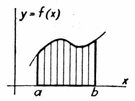
COURSE INFO
SCHEDULE
SYLLABUS
HOMEWORK
WRITING ASSIGNMENTS
OFFICE HOURS
|
Math 125, Spring 2004
Calculus 1
Writing Assignments
Give brief but clear answers to the questions below. Click on this link to send me an email with your answers. Make sure to type 'Calculus Assignment' and the date in the subject line.
For Monday, February 2
Section 1.5: Evaluating Limits Algebraically
- When might a direct substitution not work when trying to evaluate a limit? Give an example.
- If substitution and algebraic methods fail, what other methods can we use to find a limit.
- Describe, intuitively, the squeeze theorem.
For Wednesday, February 4
Section 1.6: The Slope of a curve
- What is the difference between secant and tangent lines? How does one 'become' the other?
- How does our definition of the slope of a curve follow the traditional 'change in y over change in x' format?
- What are some instances where a curve might not have a tangent line?
For Friday, February 6
Section 1.7 The Derivative
- What kind of function is the derivative? What does it measure?
- Why must a differentiable function be continuous? What other kinds of features can cause a function to not be differentiable?
- There is an exam in a week! What can we do to prepare for it in class?
For Monday, February 9
Section 1.8: Differentiation of Polynomials
- What are the two types of derivative formulas that we will encounter in this course?
- What is the derivative of the sum of two functions? How does this tie in to what we know about limits?
- How do the rules presented in section 1.8 allow us to differentiate any polynomial?
Note: You may download a copy of the practice exam here
For Wednesday, February 11
Section 1.9: The Power Rule
- What is the difference between the power rule explained in section 1.8 and that one explained in section 1.9?
- How does the reciprocal rule allow us to take the derivative of any rational function?
For Friday, February 13
Exam the First
- Study hard for the exam.
- Get a good night's sleep!
- Arrive this morning on time and prepared for the exam, both physically and mentally.
For Monday, February 16
PRESIDENTS DAY-NO CLASS
Do not fall out of the habit of doing the writing assignments, as they will continue for the entire semester!
For Wednesday, February 18
Section 1.10: The Chain Rule
- For which types of functions is the chain rule used? How does it extend the Power Rule?
- How does the 'dy/dx' formulation of the derivative give us an easy formulation of the chain rule?
- Comment: The exam was easier/about as difficult/harder than I thought it would be? Explain.
For Friday, February 20
Section 1.11: Product and Quotient Rules
- How is our notion of the derivative of a product different than our concepts of limits?
- For which values of x is the quotient rule valid?
- This section concludes (for now) our armory of derivative rules. What do you think would be the best way to help you remember what we've learned so far?
For Monday, February 23
Section 1.12: Maximum and Minimum Outputs
- Where can maxima and minima exist for a function on a closed interval?
- Give a step by step method for determining the maximum and minimum outputs of a function.
- When looking at maxima and minima, why all the fuss over whether the interval is open or closed.
For Wednesday, February 25
Section 1.13: Increasing and decreasing functions
- What does the sign of the derivative tell us about a function?
- How might we determine on which intervals a function is increasing or decreasing (give an outline of steps to use)?
- Why is calculus a better means of determining whether a function is increasing or decreasing than graphing?
For Friday, February 27
Section 1.14: The First Derivative Test
- Describe the difference between a global maximum or minimum output (discussed in section 1.12) and a relative maximum or minimum output (described in section 1.14)
- Can a function have derivative equal to zero and still not have a relative maximum or minimum output at that point? Explain.
- How does one find critical inputs for a function?
Click on this link to send me an email with your answers. Make sure to type 'Calculus Assignment' and the date in the subject line.
Barry Balof's Home Page
Whitman Math Home
Whitman College Home
|
